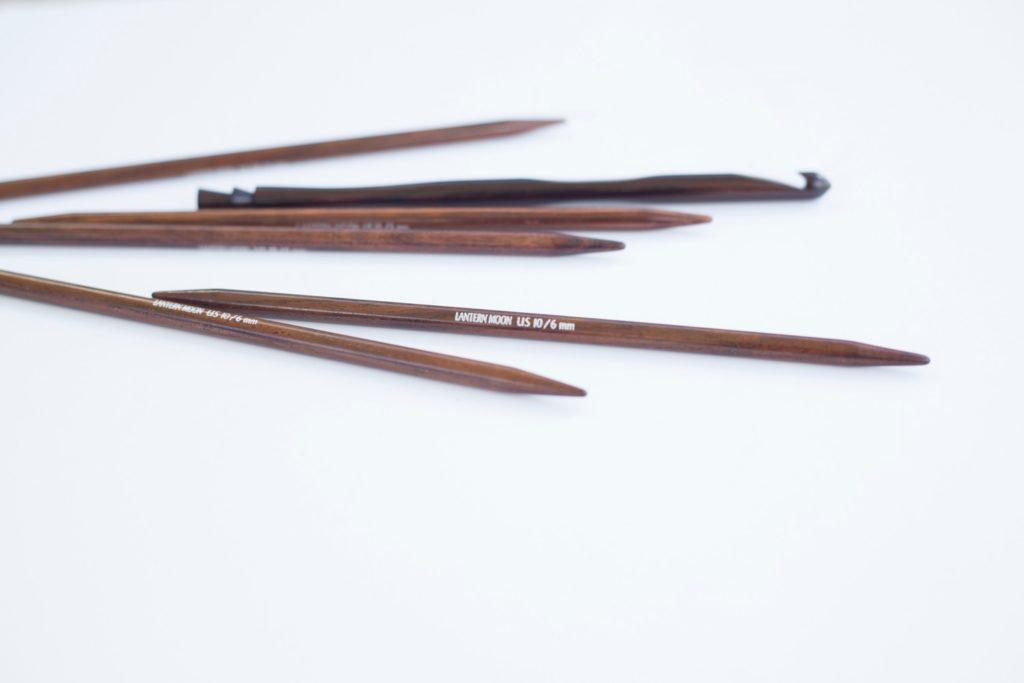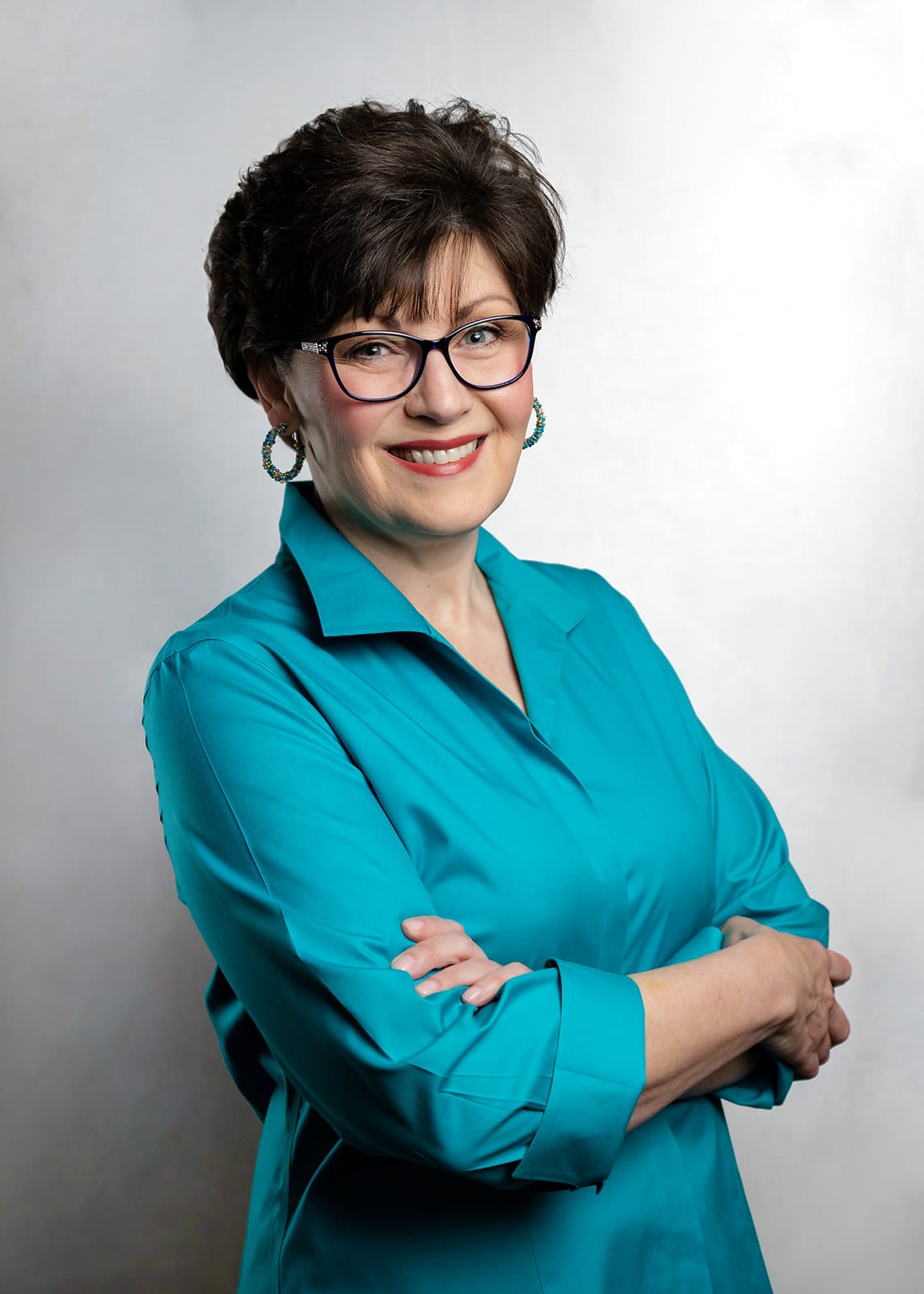Today we’re going to talk about knitting needles! Knitting needles come in an assortment of shapes and sizes and they’re made from a variety of materials. From plastic and metal to bamboo and wood – there are so many options out there that it can make your head spin. But I’m going to share some tips with you that will make choosing the right needle for your project easy-peasy. Let’s dive in!
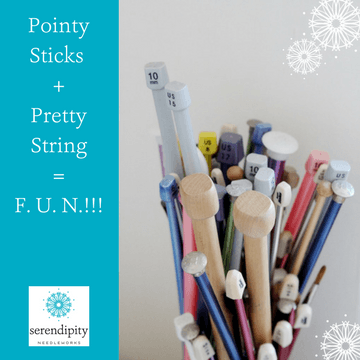
Each yarn weight category has a corresponding needle size or range of sized. Below is a handy chart for you to refer to when trying to decide which needle to use for your next project. The ball band on your yarn usually includes a suggested needle size for getting gauge and that’s a great place to start. Remember, though, that you need to knit a gauge swatch with your yarn and needles first, so you know if you’ve found the right combination. 😉
If the needles you’re using are too small for the yarn, your knitted fabric will be very dense and tight. And if the needles you’re using are too large, your knitted fabric will be loosey-goosey (and full of holes!). That’s why knitting a gauge swatch is so very important! You don’t want to spend hours of your precious time on a project that you’re not happy with in the end.
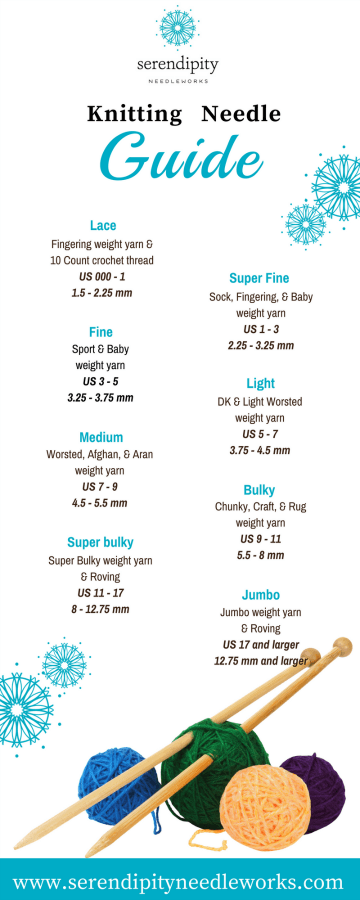
Knitting needles are available in a variety of materials and your knitting can be affected by the type of needle you choose. Let’s take a moment to look at the different kinds.
Metal Knitting Needles
Metal needles are the most common type of knitting needle. They’re smooth (even slick!) and great for increasing your speed because the yarn glides easily across them. They’re also good for helping tight knitters loosen up their tension. I don’t recommend that beginning knitters use metal needles, though. Stitches have a tendency to slip off the ends of metal needles and there’s nothing more frustrating than feeling like you can’t control your materials when you ‘re trying to learn something new.
Wood & Bamboo Knitting Needles
Wooden and bamboo needles, on the other hand, are great for beginners. (They’re also really good for knitters who tend to knit too loosely – like me!) Knitting needles made out of wood or bamboo have a bit of “tooth”, which means they hold onto the yarn a little. You’re able to maintain better control over your yarn if it’s not sliding off the tips of the needles. And, wood/bamboo knitting needles aren’t as rigid as their metal counterparts, so you’ll have less hand fatigue if you use them. I have friends with arthritis tell me that, if it weren’t for wood and bamboo knitting needles, they wouldn’t be able to knit!
Plastic & Acrylic Knitting Needles
And, finally, there’s plastic/acrylic. Plastic and acrylic needles are relatively inexpensive. That makes them a terrific choice for teaching children to knit. They’re also not quite as slippery as metal, but more slick than wood or bamboo. So, if you’re looking for a “happy medium”, you might find that plastic/acrylic needles are just the ticket.

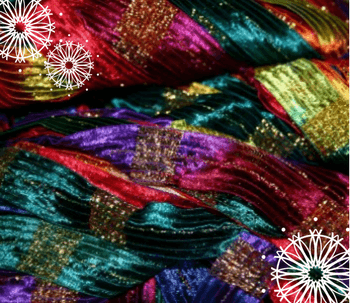
Which Kind of Knitting Needle Should You Use?
Now that you know a little about the different kinds of knitting needles, let’s chat a bit about how you might choose which kind to use. As I mentioned earlier, I recommend that everyone start with wood or bamboo knitting needles.
Why Wood?
I always use Brittany 10″ single point needles when teaching my Beginning Knitting classes because they’re…
- lightweight and they feel smooth and warm in your hands
- “sticky” – they grab onto the yarn just enough to keep it from sliding off the ends of the needle
- really pretty!
They’re also very reasonably priced and they’re made in the USA of sustainably harvested birch trees. Wood and bamboo are excellent choices when using novelty or silk yarns, too, because both kinds of yarn can be quite slippery.
When Should You Use Metal or Plastic?
Metal and plastic knitting needles are great for working with yarns that are “sticky”, like wool, mohair, and cotton. Of course, you always need to do a gauge swatch to make sure you have the correct tension so your project ends up being the right size. You can easily adjust your needle size up or down in order to get the right number of stitches per inch.
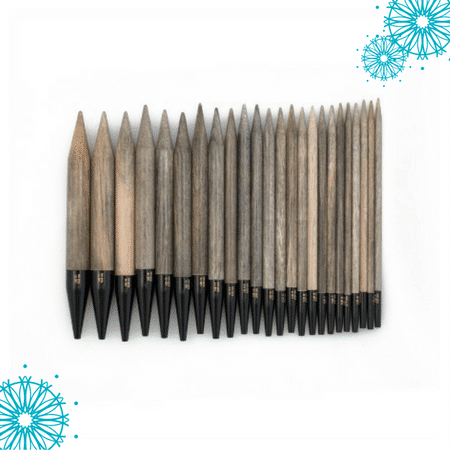
In addition to being made of a variety of materials, knitting needles also come in different styles – straight, circular, interchangeable (also circular), and double pointed.
Straight Needles
Straight needles are my “go-to” needles for flat knitting. Flat knitting is when you knit across a row on the right side, then flip your work over and work back across on the wrong side. Straight needles come in several standard lengths. Remember, the more stitches you have to knit across, the longer your needles need to be.
Circular Needles
Circular needles are just a pair of straight needle tips with a flexible cable to connect them together. Use them to knit in the round, which means you’re knitting in a continuous circular manner without turning your work. This results in a seamless tube that can be large enough for the body of a man’s sweater or small enough for a hat/beanie. You may also use circular knitting needles just like straight needles, working back and forth on a flat piece. For that reason, many people choose to use circulars instead of straights.
Interchangeable Needle Sets
In addition to fixed-length circular needles, there are oodles of interchangeable knitting needle sets available today. The beauty of interchangeable sets is that they include an assortment of tips sizes and cord lengths. That means you can create hundreds of different combinations with just a few components. Interchangeable sets are a good investment if you find you really enjoy knitting. A word of caution, though – whichever kind of circular needle you choose to use, carefully check the “join”. (The join is the place where the needle tip connects to the cord.) Make sure that it’s really smooth. It’s very frustrating to knit with circular needles when your stitches snag on a bumpy join.
Double Pointed Needles
Finally, we come to double-pointed needles, frequently called “dpns”. They have a point at each end and are generally sold in sets of five needles. They’re used in the same manner that circular needles are used — to work in the round. DPNs are used to make small tubes, though, like socks, mittens and baby hats. Use dpns anytime there are too few stitches to stretch around the cord of a circular needle.
If you’re looking for an app to help keep track of your needles and yarns, check out this article from Martha Stewart Living. It has lots of terrific suggestions.
Alrighty… that’s all for now, my friend. Have a terrific rest of your day and, until next time, happy stitching!!
XOXO!



